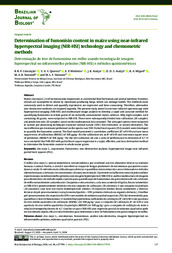Determination of fumonisin content in maize using near-infrared hyperspectral imaging (NIR-HSI) technology and chemometric methods.
Determination of fumonisin content in maize using near-infrared hyperspectral imaging (NIR-HSI) technology and chemometric methods.
Author(s): CONCEIÇÃO, R. R. P.; QUEIROZ, V. A. V.; MEDEIROS, E. P. de; ARAUJO, J. B. de; SILVA, D. D. da; MIGUEL, R. de A.; STOIANOFF, M. A. R.; SIMEONE, M. L. F.
Summary: Maize (Zea mays L.) is of socioeconomic importance as an essential food for human and animal nutrition. However, cereals are susceptible to attack by mycotoxin-producing fungi, which can damage health. The methods most commonly used to detect and quantify mycotoxins are expensive and time-consuming. Therefore, alternative non-destructive methods are required urgently. The present study aimed to use near-infrared spectroscopy with hyperspectral imaging (NIR-HSI) and multivariate image analysis to develop a rapid and accurate method for quantifying fumonisins in whole grains of six naturally contaminated maize cultivars. Fifty-eight samples, each containing 40 grains, were subjected to NIR-HSI. These were subsequently divided into calibration (38 samples) and prediction sets (20 samples) based on the multispectral data obtained. The averaged spectra were subjected to various pre-processing techniques (standard normal variate (SNV), first derivative, or second derivative). The most effective pre-treatment performed on the spectra was SNV. Partial least squares (PLS) models were developed to quantify the fumonisin content. The final model presented a correlation coefficient (R2) of 0.98 and root mean square error of calibration (RMSEC) of 508 µg.kg-1 for the calibration set, an R2 of 0.95 and root mean square error of prediction (RMSEP) of 508 µg.kg-1 for the test validation set and a ratio of performance to deviation of 4.7. It was concluded that NIR-HSI with partial least square regression is a rapid, effective, and non-destructive method to determine the fumonisin content in whole maize grains.
Publication year: 2024
Types of publication: Journal article
Unit: Embrapa Maize & Sorghum
Observation
Some of Embrapa's publications are published as ePub files. To read them, use or download one of the following free software options to your computer or mobile device. Android: Google Play Books; IOS: iBooks; Windows and Linux: Calibre.
Access other publications
Access the Agricultural Research Database (BDPA) to consult Embrapa's full library collection and records.
Visit Embrapa Bookstore to purchase books and other publications sold by Embrapa.

